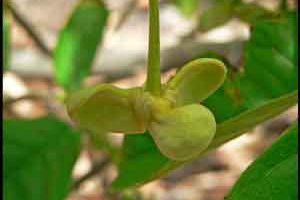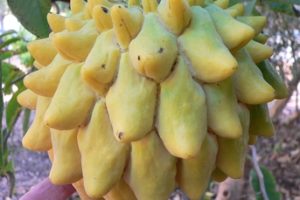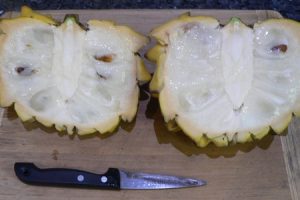Annona mucosa
Rollinia, biriba
Origin
It is native to the lowlands of Brazil and now grown in other tropical regions worldwide at up to 600m and where there is >1300mm well-distributed precipitation pa. There are about 65 species in the previously accepted genus Rollinia (now rolled into Annona), but only a few produce edible fruit.
Climate
It prefers hot, humid climates with an average annual temperature of 26°C and minima above 15°C. There is low tolerance of frosts and extended dry periods. Low temperatures retard fruit maturation and too high temperatures lead to early fruit drop.
Plant Description
A fast-growing deciduous tree, 4-10m tall, with a dense rounded canopy. The simple alternate leathery leaves are elliptical, 10-25cm long, on 5-10mm pedicels.
Relatives
Annonaceae Family. Related to Atemoya (custard apple), soursop, sugar apple, cherimoya, posh te, North American papaya.
Soils
Deep soils with a high content of organic matter and good drainage are best, but it will tolerate sandy, calcareous and clay soils outside this range and even periodic flooding.
Propogation
Seeds are recalcitrant and need to be planted fresh. Germination rates are good but there is considerable variation in yield and fruit quality between trees. There has been little development work done to date and selection of chance seedlings has been the main means of improvement. These superior trees are then usually propagated by grafting or marcots to preserve their features.
Cultivars
There are several named varieties in Brazil, India and the Philippines but these are basically unobtainable here and Nursery plants will inevitably be unnamed seedlings.
Flowering and Pollination
The flowers are solitary or in groups of 2-3, hermaphrodite, borne on long pedicels and exhibit protogynous dichogamy. Like avocados, environmental conditions can affect the degree of overlap between male and female stages, changing the degree of self-pollination possible. Pollination is the limiting factor in fruit set; below a relative humidity of 80%, this will be compromised due to pollen and stigma desiccation. Pollinators are thought to be beetles, thrips and to a lesser extent, flies.
Cultivation
It will grow in full sun or partial shade. No studies have been conducted specifically for Rollinia, but fertilization programmes for other Annonas can be used as guides. It is important not to over-fertilize, as vegetative rather than reproductive growth will result. Rollinia responds well to organic supplements and mulch. Watering in dry periods is essential.
Wind Tolerance
They are very susceptible to wind damage, particularly when young.
Pruning
Lateral branches can be long and drooping so the tree should be skirted and trimmed, as fruit loads will either cause breakages or make contact with soil.
The Fruit
It is a syncarp berry consisting of many joined carpels of radial fruitlets, which results in the skin having many soft, rounded bumps or more pronounced spines. It may be heart-shaped or spherical-oblong, 10-20cm long and weigh 200g-3kg. Fruit changes from green to yellow as it matures. The white to translucent flesh is succulent with a slender opaque core (receptacle) and many black seeds, 1-1.5cm long that are easily removed. Edible flesh is about 50% of the fruit. It has reasonable Ca, Fe and vitamin C levels and 10-20% carbohydrates.
Fruit Production and Harvesting
Seedling-grown trees have a juvenile period of 3-4 years. Fruit mature about 60 days after anthesis. Yield will increase over a number of years to the fully mature level, with well-managed 15-year-old trees producing up to 150 fruit pa. If picked when fruit are firm but starting to turn yellow, they will ripen in 3-7 days. Fully ripe fruits will develop black tips on their spines. Fruit should be clipped from the tree to minimize fruit rot, and great care needs to be exercised to avoid damage. Any damaged sections rapidly darken, eventually covering the whole fruit; at this stage it will only last 1-2 days before flesh becomes very mushy and fermentation begins.
Fruit Uses
It is usually eaten fresh, but can also be used to make milk shakes, jams, jellies, pickles and chutneys. The flesh oxidizes rapidly once the fruit is cut.
Pests and Diseases
Scale and mealy bugs can be problems, and possibly fruit fly.
Comments
Although essentially a tropical species it can be fruited here if given sufficient and regular water.


